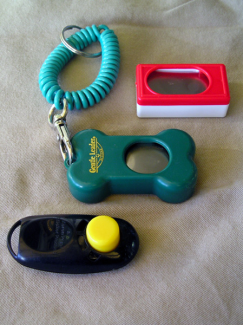Ah, the sting of watching a beloved technique get twisted into a pain-producer.
One of the most effective tools at the disposal of positive reinforcement is a clicker, a small device that generates a clearly audible “click” for marking a particular behavior in a particular moment. It doesn’t carry any of the emotional variation of words or vocal tone. It cuts through surrounding sounds. It’s a useful piece of equipment.
In positive reinforcement, that sound marks a success. Achieve a particular target behavior, get a click. With animal trainers, the sound—a secondary reinforcer—then gets followed by food—a primary reinforcer. Rover retrieves a ball, hears a click, and earns a treat. Yum. More fetching to follow. Everybody’s happy.
In human training circles, my colleagues and I use an analogous technique called TAG Teaching, where TAG stands for Teaching with Acoustical Guidance. A gymnastics coach might click her athlete for completing the “tag point” of “Keep chin up.” A speech instructor might click for “eye contact with audience.” With humans—at least those out of younger childhood—the click becomes a primary reinforcer on its own, a stand-alone signal that triggers the positive feelings of success.
Alas, not everyone works from the same model. Today, I came across a Boston Globe video that describes the work of ESL Rules, a group offering accent modification classes for Boston natives. Once you’ve pahked yah cah, you head into the room and work through reading exercises, getting a ‘click’ every time…you make a mistake!
I imagine the teacher here has positive intentions. She wants to help her clients. Some folks need to learn they’re making a mistake so they have the motivation to change. And she’s taking advantage of the clicker’s ability to mark a specific behavior.
Trouble is, she’s using the clicker as a punishment, a consequence intended to reduce an unwanted behavior. Could the technique “work,” in that it could lead to students correcting their errors? Maybe. This woman does have a 25-year career as a speech and language pathologist so she must have had some level of success. But it reaches that end while unnecessarily injecting feelings of frustration and humiliation.
Watch the video closely and you’ll notice a flinch response in the learner every time the click comes out—heck, you might feel one yourself! The teacher also rolls her eyes and smirks at a learner’s mistake. Though it might appear playful or humorous, that little judgment or rejection from the teacher puts a bit of poison in the mix. The reporter sharing the story picks up on that element too, describing the technique as a bit of “cruel and unusual punishment.”
This clicker mis-use makes me cringe even more because it comes within a larger context of vulnerability. Her students come to her to change a behavior that’s part of their cultural identity—a heritage that describes their home and family—but that they carry some shame about. Somehow they’ve gotten the sense that something’s wrong and they’re not good enough as they are. Amplifying that tenderness almost always generates reflexive defensiveness.

Change a Boston accent? Would you change Fenway Pahk? A Boston native might get a wee bit bristly at the suggestion.
Photo courtesy of Wikimedia.com.
Not surprisingly, then, using a marker this way especially builds resistance and resentment in those who struggle. Note in particular when the reporter works with his Dad—around 1:52 of the clip—and you can see the tangible frustration on the father’s face. Will this older gentleman come back to continue with this “training”? I doubt it. In this moment on film, you see him actively resist it. Again, he seems partly playful, but he’s also irritated. Anyone wanting to change an accent would have to be motivated to do so. I’m not sure this man has that motivation but I have great confidence that this technique drains away whatever impetus he started with.
These teachers do have a choice and could make a simple switch to turn the wince into a win: use the clicker for marking when students get the pronunciation right. If they say a word with ‘r’s’ and don’t hear the click, they can catch themselves—with neutral recognition rather than pointed judgment—and make the adjustment on their own.
If students still struggle, they can practice listening for someone else’s patterns—put the clicker in their hands so they know what to look and listen for. Or, teachers could break the skill down into smaller steps by helping learners distinguish exactly the tongue and mouth placement needed to support the “r” sound. Then, click them for forming that structure in the mouth before even actually articulating any words.
In all of these cases, when students reach success through their own efforts, the sound becomes a celebration and one more reason to keep going. Click equals yes. Yes equals good. Good equals more.
Keep that clicker clean, friends. It’s meant as a positive reinforcer, not a pain-inducing punisher.




areyou going to comment on their web site? I am going to write the guy who did the video…
that is really scary!!!!
I thought I might contact the business owners, yes. We’ll see how that goes!
I like this post. Nicely put
Thank you, Josh. Glad you liked it!
Thanks for sharing the article. I find it’s more positive, powerful & productive to learn & teach via positive reinforcement. If this lady would like to learn more about TAGteach, I’d love to help.
ps; the International TAGteach conference is in Verona, Italy from 4-6 September 2015 (keep an eye on http://www.tagteach.com). It’s gonna be brilliant & fun :0).